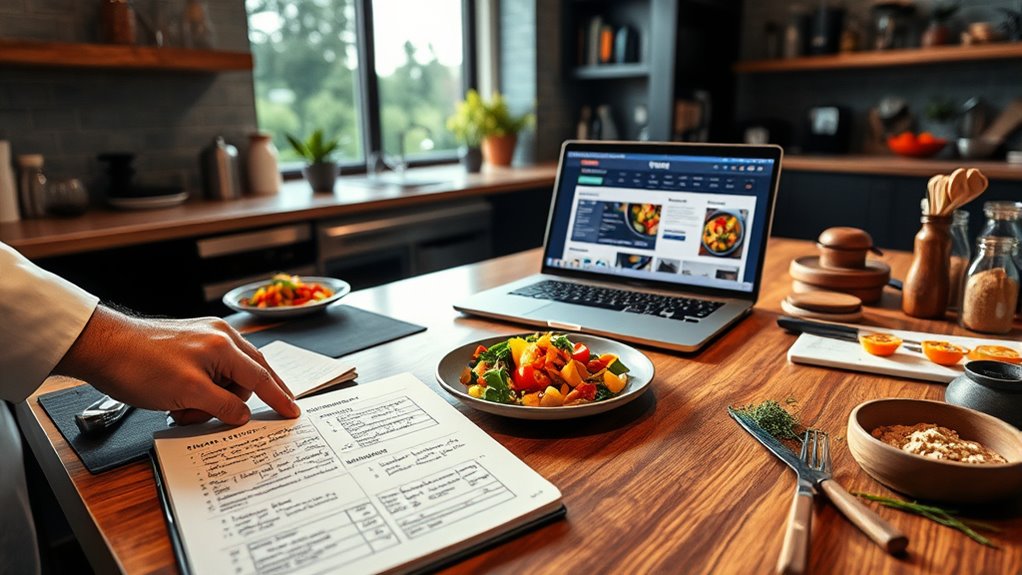Creating a menu development plan involves aligning your core ingredients with reliable suppliers to guarantee quality and consistency. You should perform detailed cost analysis to set prices that cover expenses and maximize profit margins. Balance this with customer appeal by designing a menu that offers variety and exploration. Strategic sourcing and ongoing cost evaluation help adapt to market changes, making your menu sustainable. Keep exploring to discover how to refine your approach and build a successful, profitable menu.
Key Takeaways
- Define menu concept and target audience to guide ingredient selection and dish offerings.
- Conduct cost analysis for each dish to ensure profitability and appropriate pricing strategies.
- Source ingredients from reliable suppliers, balancing quality, availability, and cost considerations.
- Align menu development with sourcing capabilities and supplier relationships for consistent quality.
- Design a balanced menu that emphasizes customer appeal, variety, and adaptability to market changes.

Are you ready to craft a menu that attracts customers and boosts your business? Developing a well-thought-out menu begins with understanding your core ingredients and how to source them efficiently. Ingredient sourcing is vital because it directly impacts the quality of your dishes and your profit margins. You need to establish relationships with reliable suppliers who can provide fresh, high-quality ingredients at reasonable prices. This involves researching local farms, wholesalers, and specialty vendors to find the best options. By building strong supplier connections, you can negotiate better deals, ensure consistent availability, and maintain the integrity of your menu offerings. Keep in mind that sourcing doesn’t just mean finding the cheapest options; it’s about balancing quality with cost to deliver dishes that satisfy your customers and support your brand.
Develop strong supplier relationships to ensure quality, affordability, and consistency in your menu ingredients.
Once you’ve identified your ingredient sources, it’s essential to conduct a thorough cost analysis. This step helps you understand the true expense behind each dish, from raw materials to preparation and overhead costs. By calculating the cost of every ingredient in your recipes, you can determine the ideal pricing that covers expenses while remaining attractive to your target audience. Cost analysis isn’t a one-time task; it’s an ongoing process that allows you to adjust as market prices fluctuate or as you refine your menu. It also helps you identify high-cost items that may need substitution or re-engineering to improve profitability. For example, if a particular ingredient is driving up dish costs, consider alternative suppliers or seasonal ingredients that can deliver similar flavor at a lower price.
Integrating ingredient sourcing and cost analysis into your menu development ensures you create a financially sustainable and appealing menu. When selecting dishes, think about how each item aligns with your sourcing capabilities and profit goals. This strategic approach prevents you from overextending your resources or offering menu items that are difficult to maintain or sell. Additionally, understanding your costs allows you to set competitive yet profitable prices, giving you flexibility in promotions or discounts without risking your bottom line. Incorporating the benefits of yoga into your routine can also improve your mental clarity and focus during this planning process, helping you make better decisions.
Ultimately, your goal should be a menu that balances quality, cost, and customer appeal. By focusing on smart ingredient sourcing and diligent cost analysis, you create a foundation for a successful, adaptable menu. This not only helps attract new customers but also keeps your existing patrons coming back, enthusiastic to explore what you have to offer. With these principles in place, you’re well on your way to building a menu that drives your business forward.
Frequently Asked Questions
How Often Should I Update My Menu?
You should update your menu at least seasonally, aligning with seasonal updates and changing customer preferences. Regular updates keep your offerings fresh and exciting, encouraging repeat visits. Pay attention to customer feedback and trends to inform your changes. If you notice slow-moving items or shifts in ingredient availability, consider more frequent adjustments. Staying flexible guarantees your menu remains relevant, appealing, and competitive throughout the year.
What Are Common Mistakes in Menu Development?
A common mistake in menu development is ignoring customer preferences, which can lead to low sales. You might also overlook effective pricing strategies, causing your menu to be either too expensive or too cheap. Failing to balance variety and focus can confuse customers. Always test new items, analyze sales data, and adjust based on what your customers want. This guarantees your menu stays appealing and profitable.
How Do I Price Menu Items Effectively?
To price menu items effectively, start with a thorough cost analysis to understand your expenses and desired profit margins. Next, research competitor pricing to guarantee your prices are competitive yet profitable. Consider the perceived value of your dishes and target customer preferences. Regularly review and adjust prices based on changes in costs, market trends, and customer feedback. This approach helps you maximize revenue while maintaining customer satisfaction.
How Can I Test New Menu Ideas?
You can test new menu ideas by gathering customer feedback through surveys or tasting events, allowing you to see what resonates. Conduct competitor analysis to identify trends and gaps in the market. Try introducing the new items on a limited basis or special menu, then monitor sales and customer responses. This approach helps you refine your offerings based on real insights, ensuring your menu stays appealing and competitive.
What Tools Assist in Menu Planning?
You can use digital tools and culinary software to assist in menu planning. These tools help you organize recipes, analyze costs, and visualize menu layouts easily. They streamline the process, allowing you to experiment with different combinations and guarantee variety. By leveraging these digital solutions, you can make informed decisions, optimize your menu for profitability, and save time, ultimately creating a well-balanced and appealing menu that meets your goals.
Conclusion
By developing a strategic menu plan, you not only enhance customer satisfaction but also boost profitability. Remember, studies show that 68% of diners are more likely to revisit a restaurant with a well-curated menu that reflects current food trends. Keep analyzing your sales data and customer feedback to refine your offerings continually. This proactive approach guarantees your menu stays fresh, appealing, and competitive, ultimately driving long-term success for your restaurant.









